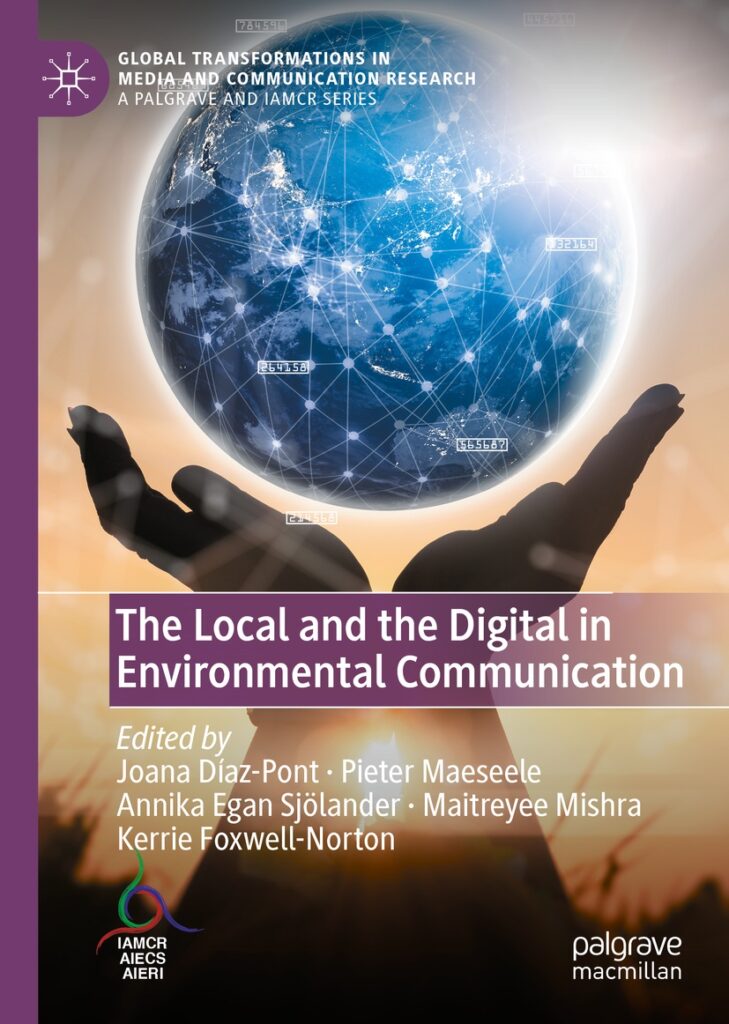In May 2020, while the whole world is suffering from the consequences of the global pandemic, the book “The Local and the Digital in Environmental Communication” is published as the tenth title in the Palgrave/IAMCR book series “Global Transformations in Media and Communication Research”.
This edited volume is unique in that it is the result of a joint initiative of both IAMCR’s Environment, Science and Risk Communication Working Group and ECREA’s Science and Environment Communication Section. It is co-edited by Joana Díaz-Pont, Pieter Maeseele, Annika Egan Sjölander, Maitreyee Mishra and Kerrie Foxwell-Norton.
One of the reasons that made this possible was my simultaneous engagement in both sections. I was elected Vice-Chair of the ESR WG at the Durban 2012 IAMCR conference, and a few months later I was also elected Vice-Chair of the SEC Section at the ECC/ECREA 2012 Istanbul conference. And I consider this volume to be one of the greatest achievements resulting from this fascinating six year period.
The seeds for it were planted during the 2017 IAMCR conference in Cartagena. As heads of the WG, we had been struck by how many papers emphasised the importance of place in environmental communication (research) on the one hand, while the role and performance of digital communication platforms had become a central focus of many presentations on the other. This seemed like an important turning point for the field, with its traditional focus on the written press, and its encapsulation in a discourse of globalization. At the same time, under the leadership of Annika Egan Sjölander, the SEC Section was preparing a symposium that would invite scholars to reflect on the existence and implications of a presumed ‘digital turn’ in science and environmental communication. In other words, the officers of both sections found a common interest in addressing the need for a scholarly debate on how digitalisation and the changing role of place affect environmental communication as a research field. The following year, the ECREA SEC Section’s symposium (typically organised in the year when the ECC conference is not held) invited prospective authors to discuss their ideas and proposals for potential contributions to the volume.
The eventual volume presents a diverse collection of 11 case studies undertaken around the globe, with a preceding conceptual chapter by the editors, and a foreword by Alison Anderson and Libby Lester. While the volume was written before the global pandemic, the issues it addresses clearly resonate in the context of families, friends and colleagues in lockdown who are at once physically disconnected and digitally connected. This volume interrogates the intertwining of the local and the digital in environmental communication. It starts by introducing a wave metaphor to tease out major shifts in the field, and situates the intersections of local places and digital networks in the beginning of a third wave. Investigations that feature the centrality of place and digital communication platforms show how we today, as researchers and practitioners, communicate the environment. Contributions identify the need for critical approaches that engage with the wider consequences of this changing media landscape, unpacking local and global tensions in environmental communication research. This empirical case study collection from different parts of the world shows that environmental activists and citizens creatively use digital technologies for campaign purposes. It identifies new environmental communication challenges and opportunities, as well as practices, of environmental activists, NGOs, citizens and local communities, in the fight for social and environmental justice.

This book:
- Examines changing scenarios in environmental communication resulting from the intertwining of ‘the digital’ and’ the local’.
- Presents a diverse collection of case studies undertaken around the globe, from Sub-Saharan Africa, East Asia and South America, to Europe, North America and Oceania.
- Highlights the increased importance of both place and people when identifying and framing environmental problems.
Contents:
- Foreword – Alison Anderson & Libby Lester
- Environmental Communication in the Intertwining of the Local and the Digital – Joana Díaz-Pont, Annika Egan Sjölander, Kerrie Foxwell-Norton, Maitreyee Mishra, and Pieter Maeseele
- Aerial Activism in Old-Growth Rainforest: The Ancient Forest Alliance’s Drone Videography as Spatial Communication – Derek Moscato
- Employing Digital Technologies in Environmental Communication Campaigns in China: A Capacity-Building Perspective – Kenneth C. C. Yang and Yowei Kang
- The Multiple Airs: Pollution, Competing Digital Information Flows and Mobile App Design in China – Matteo Tarantino
- Localizing Environmental Conflicts: Facebook Groups as Intertextual Sites for Local Protest Voices – Anders Horsbøl
- Surviving the Legacy Media System: The Place of Local Digital Activism in the Chiloé Red Tide Crisis – Claudio Broitman and René Jara
- ICTs, Environmental Activism and Community Mobilization in Senegal, Kenya and South Africa – Tracy M. Tinga, Patrick D. Murphy, and Emmanuel Septime Sessou
- Old Power Struggles and New Media Work: Indigenous Peoples’ Striving for Justice in Contemporary Brazil – Camila Emboava Lopes and Annika Egan Sjölander
- Hacking the Foodscape: Digital Communication in the Co-design of Sustainable and Inclusive Food Environments – Alana Mann
- Smart City and the Reinvented Politics of Governing Through Datafied Environment in Songdo, South Korea – Chamee Yang
- Sparking an Interest in Local Water Issues: Social Media as an Enabler for (Hyper)local Community Engagement in Environmental Issues and the Role of Solution Journalism – Franzisca Weder
- Lived, Local and Everyday: Understanding Media Use in Green Home Renovation – Aneta Podkalicka and Deb Anderson
The volume is now available in hardcover and ebook at: https://www.springer.com/gp/book/9783030373290
Enjoy the read, and let us know what you think!